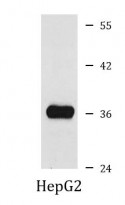ARG58460
anti-mu Crystallin antibody
anti-mu Crystallin antibody for Western blot and Human,Mouse,Rat
Overview
| Product Description | Rabbit Polyclonal antibody recognizes mu Crystallin |
|---|---|
| Tested Reactivity | Hu, Ms, Rat |
| Tested Application | WB |
| Host | Rabbit |
| Clonality | Polyclonal |
| Isotype | IgG |
| Target Name | mu Crystallin |
| Antigen Species | Human |
| Immunogen | Recombinant fusion protein corresponding to aa. 1-314 of Human mu Crystallin (NP_001879.1). |
| Conjugation | Un-conjugated |
| Alternate Names | NADP-regulated thyroid-hormone-binding protein; DFNA40; Ketimine reductase mu-crystallin; EC 1.5.1.25; THBP |
Application Instructions
| Application Suggestion |
|
||||
|---|---|---|---|---|---|
| Application Note | * The dilutions indicate recommended starting dilutions and the optimal dilutions or concentrations should be determined by the scientist. | ||||
| Positive Control | HepG2 | ||||
| Observed Size | 36 kDa |
Properties
| Form | Liquid |
|---|---|
| Purification | Affinity purified. |
| Buffer | PBS (pH 7.3), 0.02% Sodium azide and 50% Glycerol. |
| Preservative | 0.02% Sodium azide |
| Stabilizer | 50% Glycerol |
| Storage Instruction | For continuous use, store undiluted antibody at 2-8°C for up to a week. For long-term storage, aliquot and store at -20°C. Storage in frost free freezers is not recommended. Avoid repeated freeze/thaw cycles. Suggest spin the vial prior to opening. The antibody solution should be gently mixed before use. |
| Note | For laboratory research only, not for drug, diagnostic or other use. |
Bioinformation
| Database Links | |
|---|---|
| Gene Symbol | CRYM |
| Gene Full Name | crystallin, mu |
| Background | Crystallins are separated into two classes: taxon-specific and ubiquitous. The former class is also called phylogenetically-restricted crystallins. The latter class constitutes the major proteins of vertebrate eye lens and maintains the transparency and refractive index of the lens. This gene encodes a taxon-specific crystallin protein that binds NADPH and has sequence similarity to bacterial ornithine cyclodeaminases. The encoded protein does not perform a structural role in lens tissue, and instead it binds thyroid hormone for possible regulatory or developmental roles. Mutations in this gene have been associated with autosomal dominant non-syndromic deafness. [provided by RefSeq, Sep 2014] |
| Function | Specifically catalyzes the reduction of imine bonds in brain substrates that may include cystathionine ketimine (CysK) and lanthionine ketimine (LK). Binds thyroid hormone which is a strong reversible inhibitor. Presumably involved in the regulation of the free intracellular concentration of triiodothyronine and access to its nuclear receptors. [UniProt] |
| Cellular Localization | Cytoplasm. [UniProt] |
| Calculated MW | 34 kDa |
Images (1) Click the Picture to Zoom In






